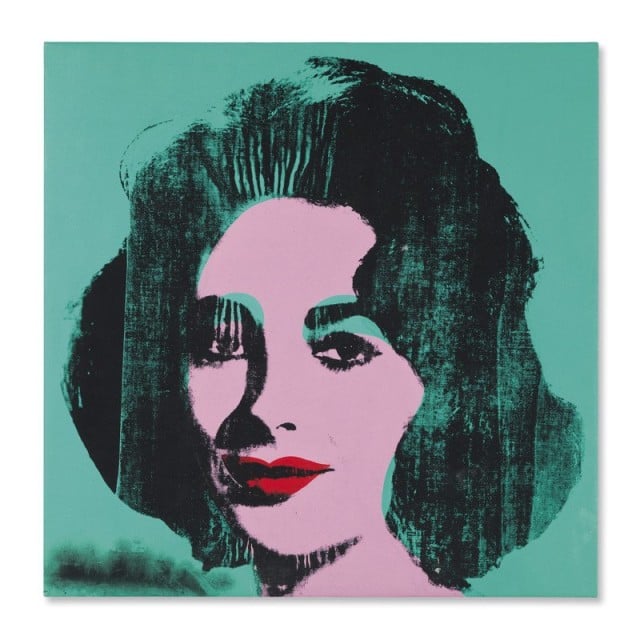
THE DAILY PIC (#1548): “The best art is the most expensive because the art market is so smart,” the auctioneer Tobias Meyer once said. I bet he’s wanted to walk that line back after any number of notably dumb auction results – including the ones that came in Tuesday night after the evening sale at Christie’s in New York.
The above Warhol painting of Liz Taylor, estimated at “only” $10 million to $15 million, failed entirely to sell or even to attract any bids. (I know, my writing “only” is an absurdity, but such is the world—the art world—we live in. Other Liz paintings have fetched far more. According to the artnet Price Database, Liz #3, against a pea green background sold for $31.5 million at Sotheby’s in 2014; Silver Liz (diptych) sold for $28 million at Christie’s in 2015; and Liz No. 5 (Early Colored Liz), on a blue background, sold for $27 million at Phillips in 2011.) In that same Christie’s sale on Tuesday, a 1982 painting by Jean-Michel Basquiat set a record at $57.3 million.
The unsold Warhol was by an artist who changed almost everything in Western art and a good bit in world culture; it also happens to be of one of that genius’s most iconic subjects. (There are rumors about some recent problems around the painting’s ownership, but no one questions that Warhol made it – a forger or copyist or even an assistant wouldn’t have dared to make Liz’s face as “distressed” as it is in this work, giving her the look of road kill. The painting is almost a hybrid between a celebrity film-still and one of Warhol’s Death and Disaster images – just the kind of art-historical complexity that collectors don’t want to deal with.)
Meanwhile, the Basquiat that did sell, for the cost of a passenger plane, is by a really pretty good 1980s neo-expressionist painter – expressionism being sucker bait for many big-time collectors, who still love, and can’t get beyond, the hideous cliché of the tortured artist applying tortured paint in a signature gesture of “self-expression.” Christie’s essay on the work bathes in such advertorial bromides, expressed in an overripe connoisseurial language that would get any grad student in art history flunked.
Basquiat’s painting has the added virtue of being big, something collectors also like, since they and the art market mostly judge aesthetics in terms of square footage. (Actually, since the Basquiat was 12 times bigger than the Warhol but only about five times more expensive, the buyer may have calculated that he got a bargain.) Basquiat does matter to art history for the way he dealt with black identity and culture(s), and with the place a black painter could have in a lily-white art world, but the Christie’s catalog steers clear of such thorny stuff, which would hardly appeal to clients among the .1 per cent.
The sale had plenty of other such absurdities. (For instance, an important early Richard Prince photo-appropriation went for around $3 million, while a drippy—and yes, big and “expressive”—later Nurse painting sold for three times more.) But I’ll leave the last word in this story to Helen Molesworth, the reliably sharp chief curator of MoCA in Los Angeles, who said the following in a recent interview with the Art Newspaper: “The rise of art as an asset class has made a lot of things worse for a lot of people—women and men. It’s a low moment in the development of Western civilization.” (© The Andy Warhol Foundation for the Visual Arts, Inc / Artists Rights Society (ARS), New York)
UPDATE (Friday May 13): The Warhol Foundation, which consigned the work to Christie’s for the May 10 sale, has confirmed to artnet News that the work was the same one that was involved in the 2014 lawsuit by the foundation against Warhol’s former bodyguard Agusto Bugarin, who had been trying to sell the silkscreen at New York’s Taglialatella Galleries. While Bugarin claimed the artist had presented the artwork to him as a gift, the Foundation insisted the artwork was stolen. Judge Cynthia Kern signed an order blocking the sale of the work. A couple of months later, two of Warhol’s nephews came to Bugarin’s defense, citing their firsthand knowledge of the friendship between the two men as evidence the work was a gift.
Additional reporting, in update, by Sarah Cascone.
For a full survey of past Daily Pics visit blakegopnik.com/archive.